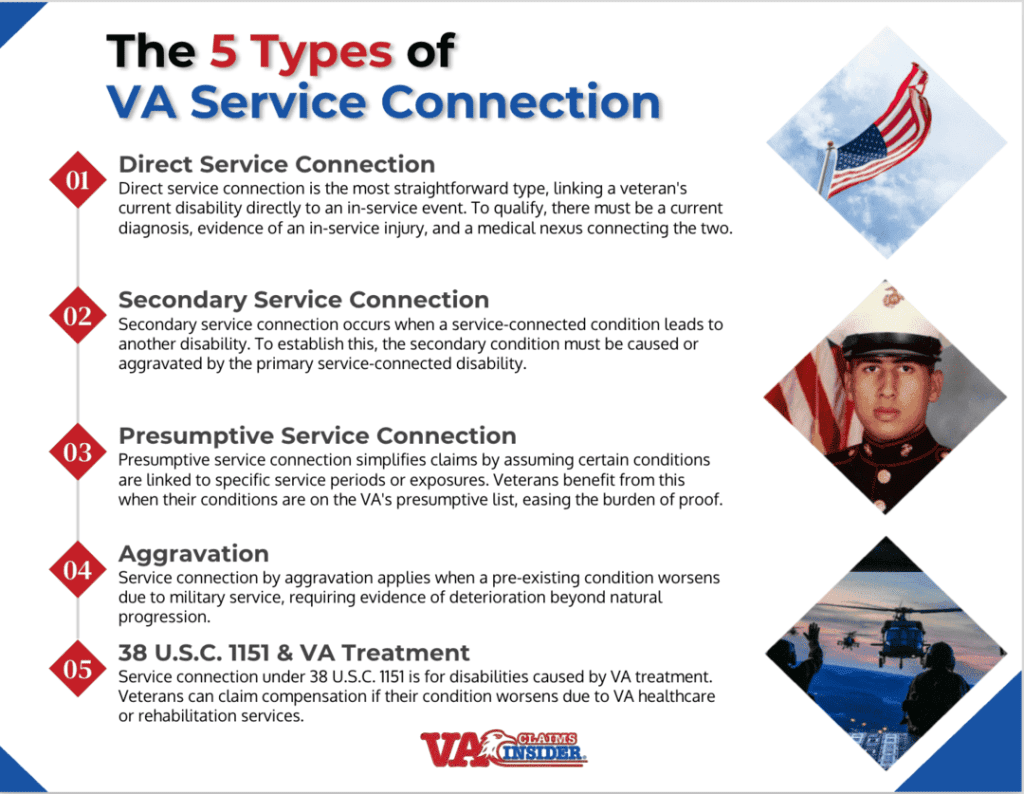Looking for Expert-Level VA Claim Answers?📱Call Us Now! 737-295-2226
As a veteran, understanding what a service-connected VA disability is—and how to establish it—is crucial for getting the benefits you deserve.
The VA offers disability compensation to veterans whose conditions are linked to their military service.
But here’s the kicker: securing these benefits hinges on one critical factor—establishing service connection.
In this article, I’ll walk you through the 5 main types of service connection for VA disability, breaking down their unique criteria and examples.
By the end, you’ll be equipped with the knowledge to navigate the VA disability system with confidence and clarity!
Table of Contents
Summary of Key Points
- Understanding Service-Connected VA Disability: Recognizing and establishing a service connection is vital for veterans to access VA disability benefits. No service connection; no VA benefits.
- 5 Types of Service Connection: There are five primary types of service connection—Direct, Presumptive, Secondary, Aggravation, and 38 U.S.C. 1151—each with its unique eligibility criteria.
- Importance of Documentation: Proper documentation, including service treatment records, medical nexus letters, and timely filing, is crucial for successfully establishing service connection.
- Navigating the VA Disability System: By understanding the different types of service connections, veterans can confidently navigate the VA disability system to secure the benefits they deserve.
#1. Direct Service Connection
“The Most Common and Straightforward Route”
Direct service connection is the most straightforward form of service connection.
It applies when a veteran’s disability or condition is directly related to an injury, illness, or event that occurred during military service.
Eligibility Criteria:
- Current Diagnosis: You must have a current diagnosis of the disability.
- In-Service Event: There must be evidence of an in-service event, injury, or illness.
- Nexus: A medical nexus must link the current disability to the in-service event.
- Symptoms: You must have current symptoms in terms of frequency, severity, and duration.
Example: A veteran who sustained a knee injury during a training exercise and later develops chronic knee pain or arthritis could establish a direct service connection.
Pro Tip: Always ensure your service treatment records (STRs) clearly document any in-service event, injury, or illness. If you didn’t seek medical attention at the time, obtaining buddy statements or personal statements detailing the event can be crucial. If you’ve been out of the military for more than 12 months or if your STRs aren’t clear that your condition existed during service, ensure you get a nexus letter from a healthcare provider that’s specific and directly links your current diagnosis to your in-service event.
#2. Presumptive Service Connection
“When the VA Does the Heavy Lifting”
Presumptive service connection is granted when the VA assumes that certain conditions are related to specific service periods, exposures, or locations, making the process easier for you.
Eligibility and Qualifying Conditions:
- The condition must be one that the VA presumes is related to specific service or exposure. Here’s the current VA presumptive list of 200+ conditions.
Example: A Vietnam veteran who develops ischemic heart disease is presumed to have a service connection due to presumed exposure to Agent Orange.
Pro Tip: Keep track of any legislative changes, such as the PACT Act, which may add new conditions or locations to the presumptive service connection list. If you served in a qualifying location or during a specific period, consult the VA’s list of presumptive conditions regularly to ensure you’re not missing out on potential benefits. Always update your medical records and file claims promptly when new presumptive conditions are added if you’re eligible. Remember, all you need is a medical diagnosis of a condition on the VA’s presumptive list and your DD 214. You don’t need a nexus letter for presumptive conditions.
#3. Secondary Service Connection
“When One Condition Leads to Another”
Secondary service connection is granted when a service-connected condition causes or aggravates another condition.
While the secondary condition might not be directly related to service, it’s linked to the primary service-connected disability.
Eligibility Criteria:
- Primary Service-Connected Condition: You must already have a service-connected disability.
- Secondary Condition: The secondary condition must be caused or aggravated by the primary service-connected condition.
Example: A veteran with service-connected diabetes develops peripheral neuropathy as a result of the diabetes. The peripheral neuropathy can be service-connected as secondary to diabetes.
Pro Tip: Monitor your health for any conditions that might be related to your primary service-connected disability. If you notice symptoms of a secondary condition, seek medical advice immediately and have your healthcare provider document the connection between the two conditions. A nexus letter is crucial if you plan to file for secondary service connection. Ensure the letter clearly explains how the new disability is proximately due to or aggravated by the current service-connected primary disability.
#4. Service Connection by Aggravation
“When Service Makes a Pre-Existing Condition Worse”
Service connection by aggravation applies when a pre-existing condition worsens during military service beyond its natural progression.
This type of service connection ensures that you’re compensated for the additional harm caused by your service.
Eligibility Criteria:
- Pre-Existing Condition: The condition must have existed before you entered service.
- Aggravation: There must be evidence that the condition worsened during service beyond its natural progression.
Example: A veteran with a pre-existing asthma condition that becomes significantly worse during military service could establish service connection by aggravation.
Pro Tip: If you had a pre-existing condition before service, make sure it is well-documented in your enlistment medical records. If the condition worsened during service, gather all relevant medical records, including any treatments or assessments during and after service, to demonstrate how the condition was aggravated. A clear, detailed account of how your condition worsened during service is essential for establishing a connection by aggravation. It’s helpful to get a nexus letter from a private healthcare provider to explain how your disability was aggravated by your service and not by the natural progression of the disability.
#5. Service Connection Based on 38 U.S.C. 1151
“When VA Treatment Causes Harm”
This type of service connection is granted for disabilities caused by VA healthcare, vocational rehabilitation, or compensated work therapy.
It applies when a veteran’s condition is worsened or caused by VA treatment.
Eligibility Criteria:
- VA Care or Treatment: The disability or death must be caused by VA healthcare, rehabilitation, or vocational services.
- Additional Disability: You must have an additional disability as a result of the VA’s actions.
Example: A veteran who suffers a surgical complication during a VA-provided surgery, leading to a new disability, may receive compensation under 38 U.S.C. 1151.
Pro Tip: If you believe a VA-provided treatment or procedure has caused or worsened a disability, request copies of all medical records related to the treatment and consult with a medical expert to assess your situation. Ensure that the medical expert can provide a nexus letter that explicitly details how the VA’s care led to your additional disability. Timely filing is crucial, so act quickly to gather evidence and submit your claim.

Final Thoughts
Understanding these five types of service connection is essential to maximizing your VA disability benefits.
Each type has its unique criteria and strategies for success, so being informed and prepared is your best defense in securing the compensation you deserve.
Remember, the journey to service connection is a marathon, not a sprint—stay patient, persistent, and proactive.
VA Service Connection: Frequently Asked Questions (FAQs)
What is VA service connection?
VA service connection is a determination by the Department of Veterans Affairs (VA) that a veteran’s current disability is linked to their military service. This connection is essential because it qualifies veterans for disability compensation. The VA must establish that the disability was caused or aggravated by an event, injury, or illness that occurred during service. This link, often called the “nexus,” is the cornerstone of a successful VA disability claim.
What are the types of VA service connection?
There are five main types of VA service connection: Direct Service Connection, Presumptive Service Connection, Secondary Service Connection, Service Connection by Aggravation, and Service Connection based on 38 U.S.C. 1151. Each type has its own criteria and application, designed to address the different ways in which military service can impact a veteran’s health. Understanding these types is crucial for veterans seeking to maximize their benefits.
How do I establish direct service connection?
To establish a direct service connection, a veteran must meet three key criteria: (1) a current diagnosis of the disability, (2) evidence of an in-service event, injury, or illness, and (3) a medical nexus linking the current disability to the in-service event. This means that the veteran must provide medical records or other evidence that their current condition is directly related to something that occurred during their time in the military. The nexus is often established through a medical opinion from a healthcare provider.
What is presumptive service connection?
Presumptive service connection is a type of service connection where the VA assumes that certain conditions are related to specific military service experiences, such as exposure to hazardous substances or serving in particular locations. Veterans with conditions on the VA’s presumptive list do not need to provide the same level of proof as those seeking direct service connection. For example, Vietnam veterans exposed to Agent Orange are presumed to have service-connected conditions like ischemic heart disease, without needing to prove a direct link to their service.
Can I get service connection for a condition that is not directly related to service?
Yes, you may be eligible for secondary service connection if a service-connected condition causes or aggravates another condition. For example, if a veteran has a service-connected knee injury that leads to back problems due to altered gait, the back problems can be service-connected as secondary to the knee injury. The key to establishing secondary service connection is showing that the secondary condition is “proximately due to” or aggravated by the primary service-connected condition.
How do I establish service connection by aggravation?
Service connection by aggravation applies when a veteran had a pre-existing condition before entering military service that worsened during their service beyond its natural progression. To establish this, the veteran must provide evidence that the condition worsened during service and that this worsening was not merely the natural course of the condition. Medical records, expert opinions, and documented in-service incidents that exacerbated the condition are crucial in proving this type of connection.
Can I get service connection for a condition caused by VA treatment?
Yes, under 38 U.S.C. 1151, you may be eligible for service connection if a VA-provided treatment or procedure caused or worsened a disability. This type of claim applies when a veteran suffers additional disability or death as a result of VA healthcare, rehabilitation, or vocational training. To establish this connection, you must show that the additional disability was a direct result of the VA’s actions and not merely a coincidental progression of an existing condition.
What evidence do I need to support my service connection claim?
To support your service connection claim, you will need to provide comprehensive evidence, including medical records documenting your current diagnosis, service records showing the in-service event, and a nexus letter from a healthcare provider linking your condition to your military service. Lay statements from fellow service members, friends, or family members can also support your claim by providing firsthand accounts of your condition during and after service.
How long does the service connection process take?
The length of the service connection process varies depending on the complexity of the claim and the speed of evidence gathering. On average, it can take several months to over a year. The VA may request additional information or schedule Compensation & Pension (C&P) exams to evaluate your condition, which can extend the timeline. Staying organized and responsive to VA requests can help expedite the process.
Can I appeal a denied service connection claim?
Yes, if your service connection claim is denied, you have the right to appeal the decision. You can file a Notice of Disagreement (NOD) with the VA, requesting a review of your case. During the appeal process, you can submit additional evidence, such as new medical opinions or clarifications, to strengthen your claim. The appeals process can be lengthy, but it offers a critical opportunity to obtain the benefits you deserve.
Veterans: YOU SERVED. YOU DESERVE. We Got Your Six!
- VA Claims Insider is the #1 most trusted name in VA disability claims.
- Work directly with a VA claims coach who can help lead you to VA claim victory.
- 25,000+ disabled veterans served in our membership programs since 2016.
- 30% average rating increase for veterans who complete our #1 rated Elite program.
- 4.7/5.0 average rating out of 5,500+ total reviews; over 4,500 5-star reviews.
About the Author

Brian Reese
Brian Reese is a world-renowned VA disability benefits expert and the #1 bestselling author of VA Claim Secrets and You Deserve It. Motivated by his own frustration with the VA claim process, Brian founded VA Claims Insider to help disabled veterans secure their VA disability compensation faster, regardless of their past struggles with the VA. Since 2013, he has positively impacted the lives of over 10 million military, veterans, and their families.
A former active-duty Air Force officer, Brian has extensive experience leading diverse teams in challenging international environments, including a combat tour in Afghanistan in 2011 supporting Operation ENDURING FREEDOM.
Brian is a Distinguished Graduate of Management from the United States Air Force Academy and earned his MBA from Oklahoma State University’s Spears School of Business, where he was a National Honor Scholar, ranking in the top 1% of his class.



